Thermal energy is the internal energy associated with a substance’s or system’s temperature. Thermal energy can refer to the heat absorbed and retained by the Earth’s land surfaces in the context of land masses.
Climate change has a wide range of consequences. The most well-known is global warming, which is caused by heat buildup in various parts of the Earth system, including the atmosphere, ocean, cryosphere, and land. The oceans store 89 percent of the excess heat, with the remainder stored in ice and glaciers, the atmosphere, and land masses (including inland water bodies).
An international research team led by the Helmholtz Centre for Environmental Research (UFZ) has now investigated the amount of heat stored on land, demonstrating the distribution of land heat among continental ground, permafrost soils, and inland water bodies. The calculations, which were published in Earth System Dynamics, show that more than 20 times as much heat has been stored there since the 1960s, with the ground experiencing the greatest increase.
The rise in anthropogenic greenhouse gases in the atmosphere prevents heat from being emitted into space. As a result, the earth constantly absorbs more heat via solar radiation than it can return via thermal radiation. Previous research has shown that this extra energy is stored primarily in the oceans (89 percent), but also in the continents’ land masses (5-6 percent), ice and glaciers (4 percent), and the atmosphere (1-2 percent). However, this understanding is insufficient: For example, it was previously unknown how this extra heat was distributed across the continents.
Although the amount of heat stored in permafrost may only account for nine percent of continental heat storage, the recent increase promotes the release of greenhouse gases such as carbon dioxide and methane due to permafrost thawing.
Francisco José Cuesta-Valero
The research team, led by the UFZ and including scientists from the Alfred Wegener Institute (Helmholtz Centre for Polar and Marine Research (AWI), Vrije Universiteit Brussel, and other research institutions, was able to more precisely quantify how much heat was stored in the continental land masses between 1960 and 2020. As a result, between 1960 and 2020, continental landmasses absorbed a total of 23.8 x 1021 Joules of heat.
For comparison, this is roughly 1800 times Germany’s electric power consumption over the same time period. The majority of this heat, approximately 90%, is stored up to 300 metres deep in the earth. 9 percent of the energy is used to thaw permafrost in the Arctic, with the remaining 0.7 percent stored in inland bodies of water such as lakes and reservoirs. “Although inland water bodies and permafrost store less heat than the ground, they must be continuously monitored because the additional energy in these subsystems causes significant changes in ecosystems,” says UFZ researcher and study lead author Francisco José Cuesta-Valero.
The scientists also demonstrated that the quantity of heat stored in the ground, in permafrost and in lakes has been increasing continuously since the 1960s. For example, a comparison of the two decades from 1960-1970 and from 2010-2020, this quantity increased by nearly 20 times from 1.007 to 18.83 x 1021 Joules in the ground, from 0.058 to 2.0 x 1021 Joules in permafrost regions and from -0.02 to 0.17 x 1021 Joules in inland water bodies.

The researchers used over 1,000 temperature profiles from around the world to calculate the amount of heat stored at depths of up to 300 meters. They used models to calculate thermal storage in permafrost and inland bodies of water. To model the waters, for example, they combined global lake models, hydrological models, and earth system models. They used a permafrost model that accounts for various plausible distributions of ground ice in the Arctic to estimate thermal storage in permafrost.
“Using models enabled us to compensate for the lack of observations in many lakes and in the Arctic, as well as to better estimate the uncertainties due to the limited number of observations,” explains Francisco José Cuesta-Valero.
The quantification of thermal energy is important because its increase is associated with processes that can change ecosystems and thus have societal consequences. This is true, for example, of the Arctic’s permanently frozen ground.
“Although the amount of heat stored in permafrost may only account for nine percent of continental heat storage, the recent increase promotes the release of greenhouse gases such as carbon dioxide and methane due to permafrost thawing,” says Francisco José Cuesta-Valero.
If the thermal energy stored in the ground increases, the earth’s surface heats up, threatening the stability of the carbon pool in the ground, for example. In agricultural areas, the associated warming of the surface may jeopardize harvests and thus population food security. The changing thermal state of inland bodies of water may have an impact on ecosystem dynamics: Water quality deteriorates, the carbon cycle is disrupted; algal blooms increase, affecting oxygen concentration and primary productivity, thereby affecting fishery production.
Therefore, co-author Prof. Dr. Jian Peng, head of the UFZ Remote Sensing Department, summarizes: “It is important to more precisely quantify and monitor how much additional heat is absorbed by the continental land masses. This is a key metric for understanding how changes in natural processes resulting from heat storage will affect humans and nature in the future.”





